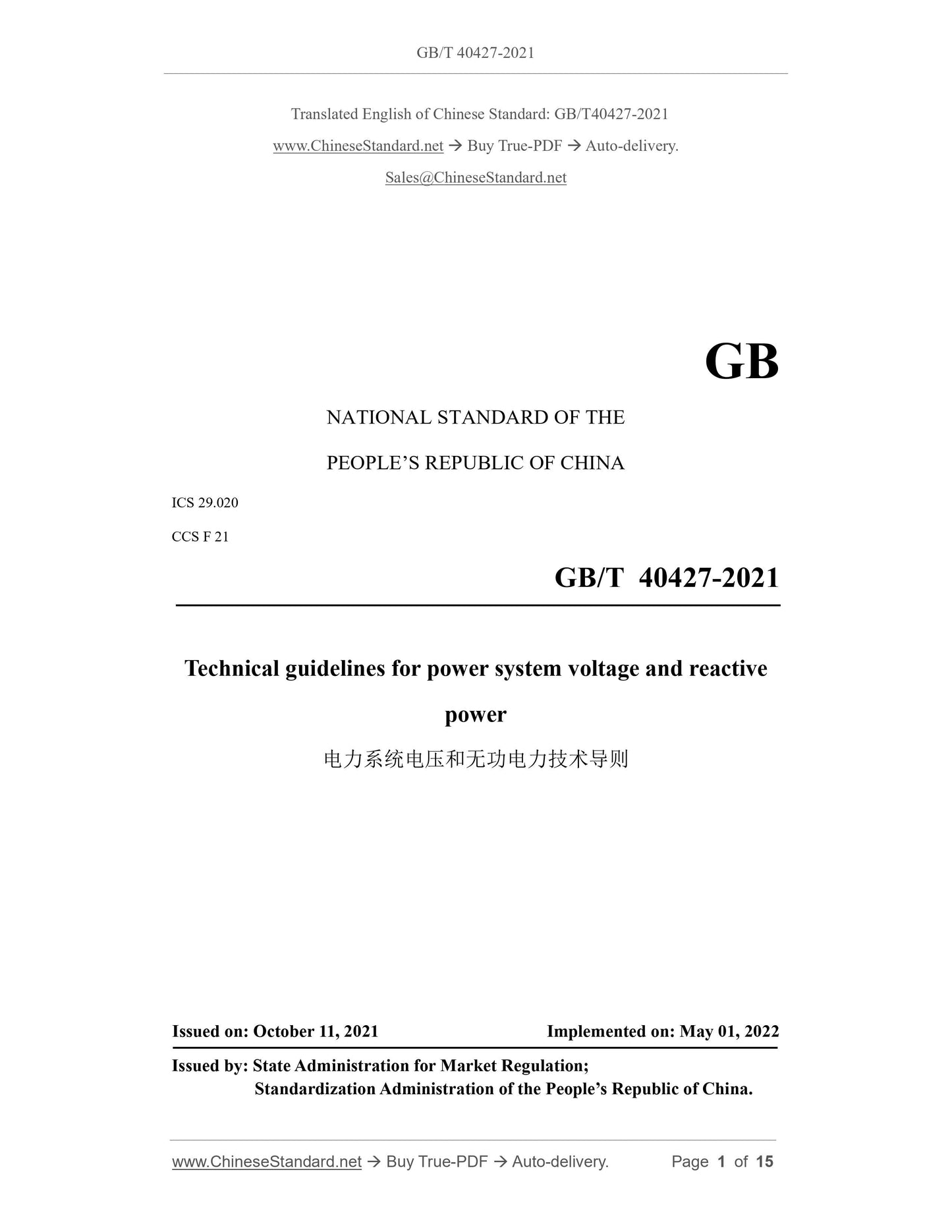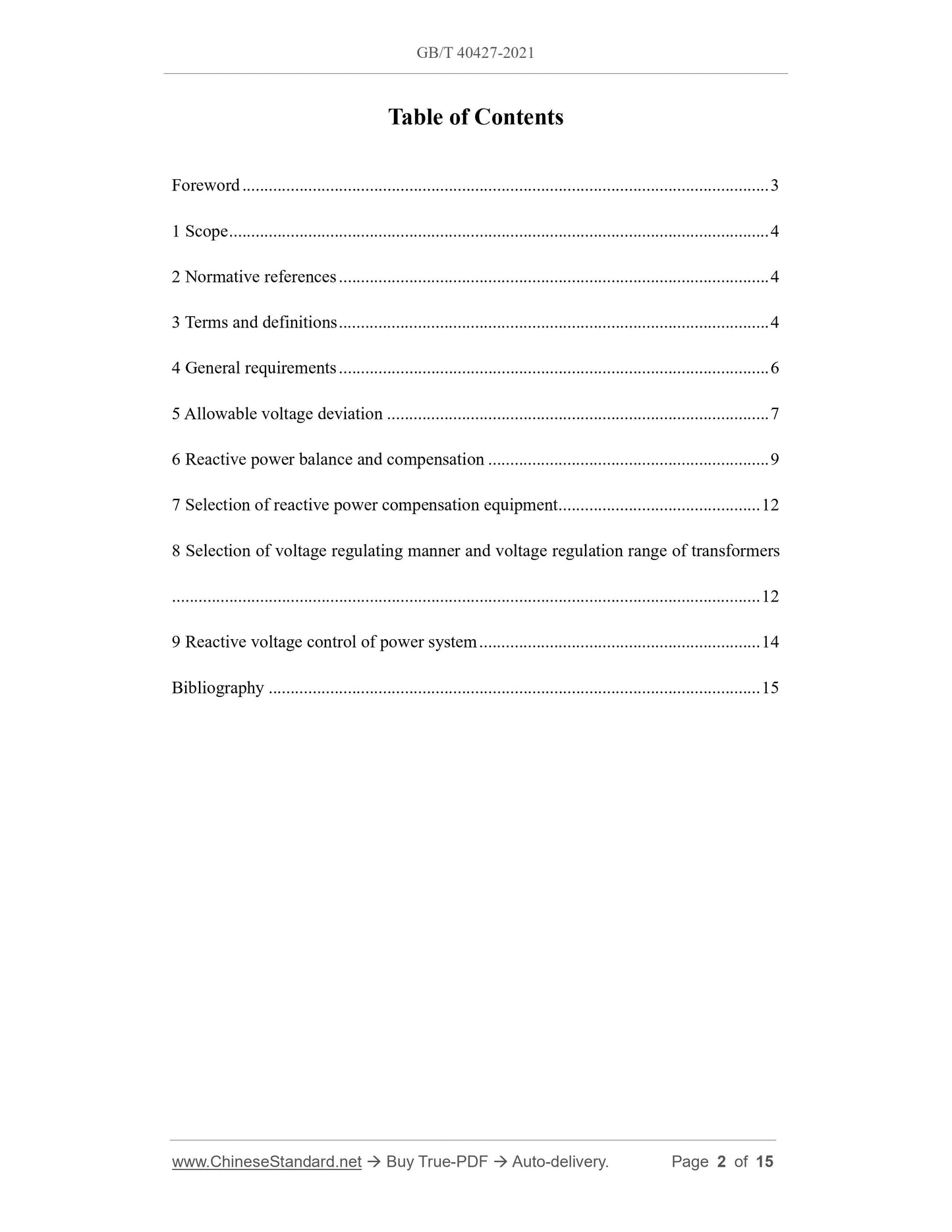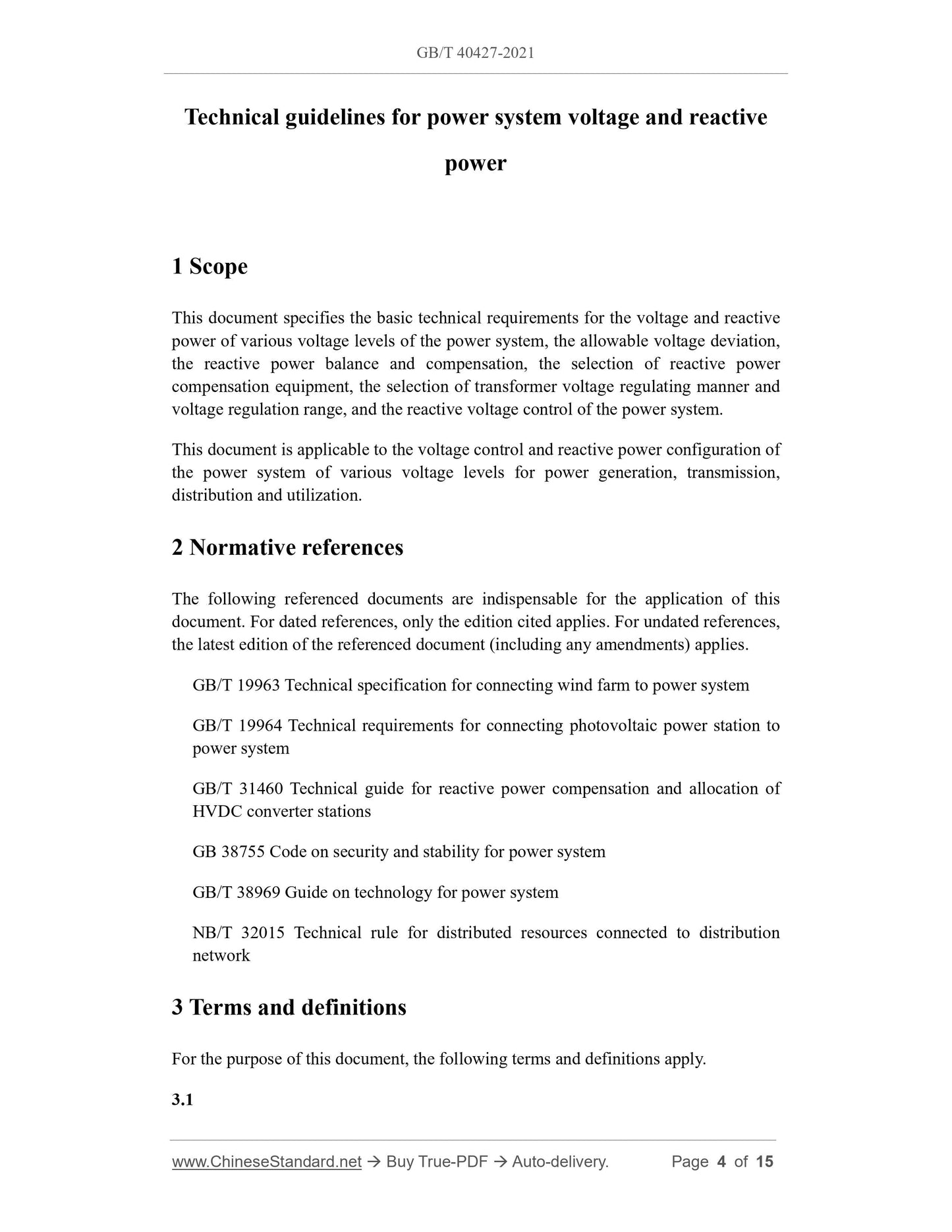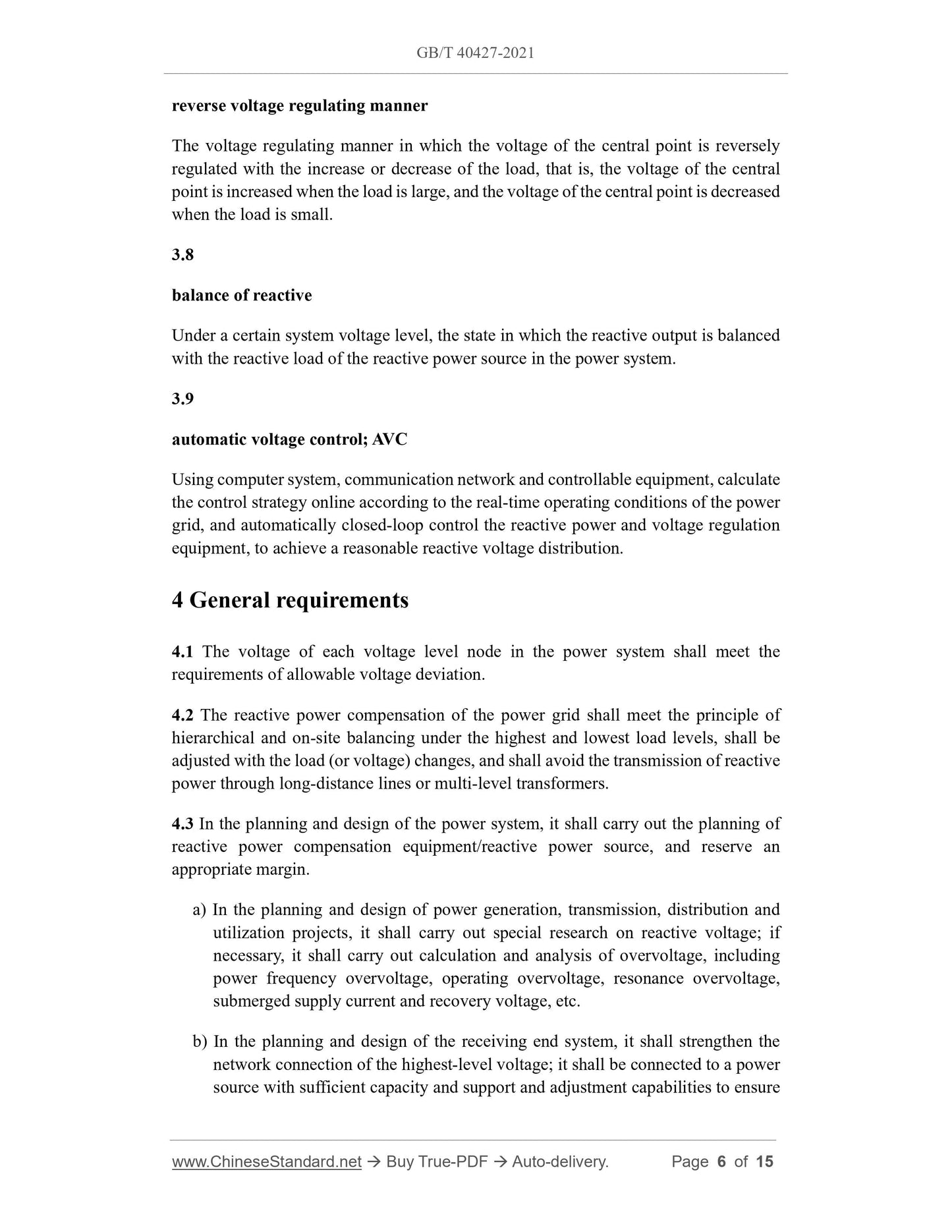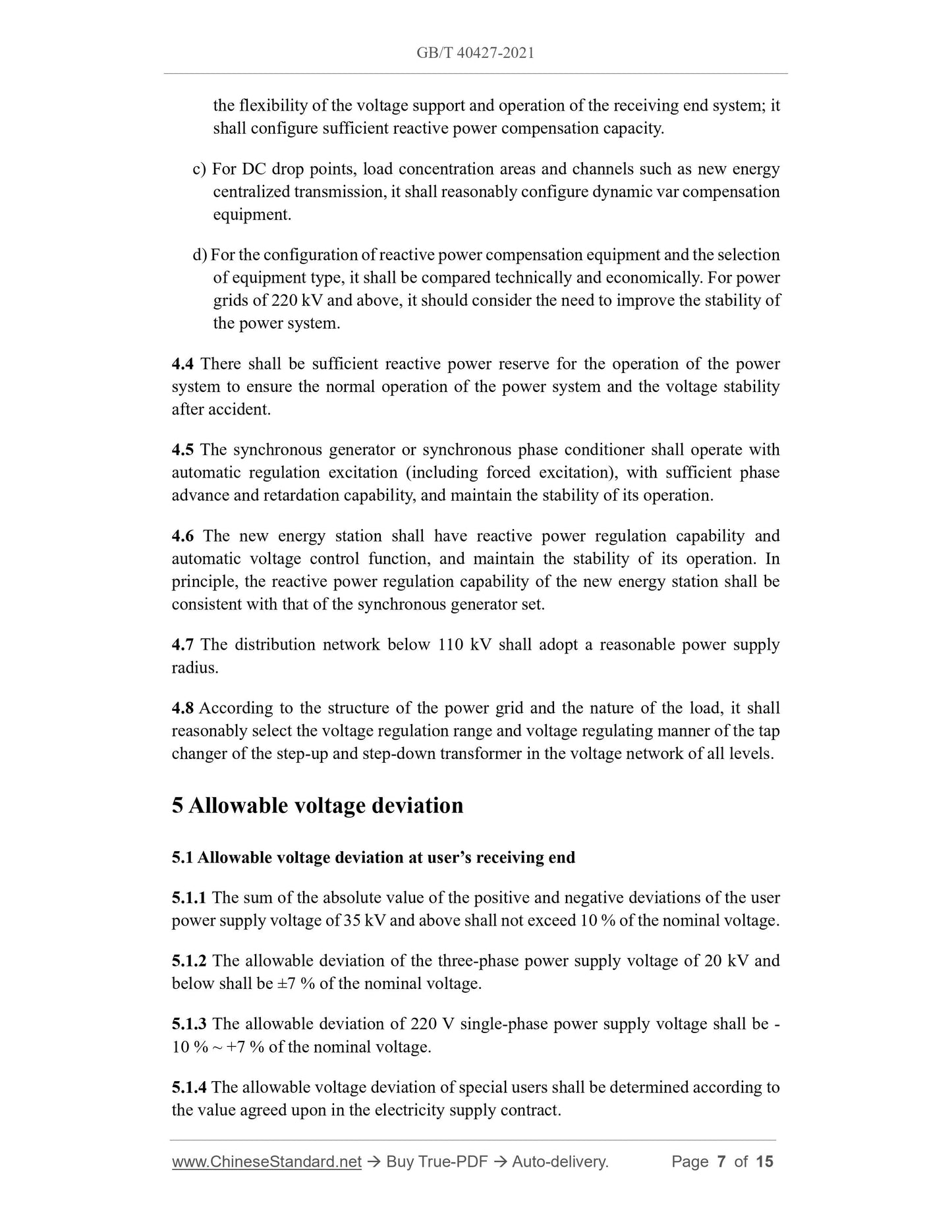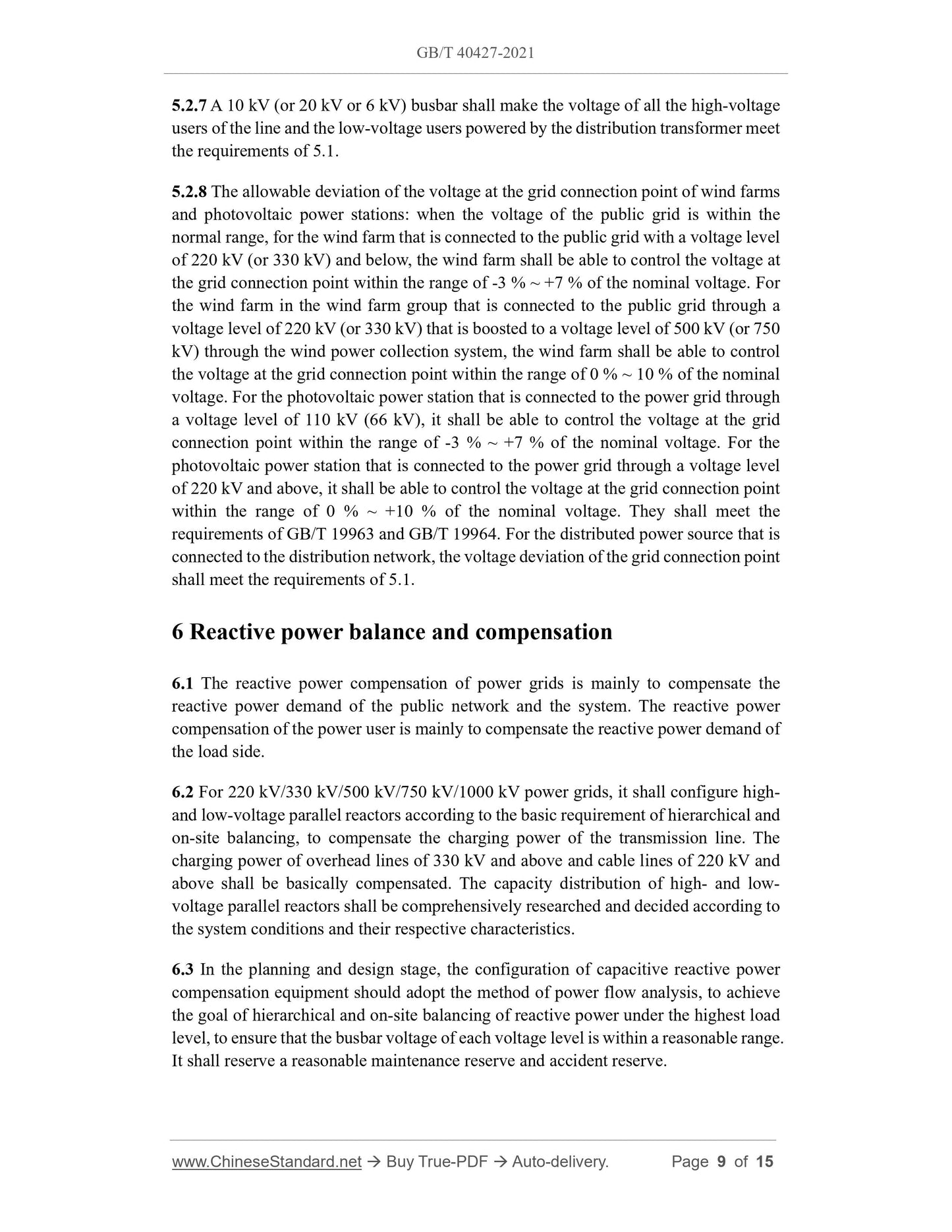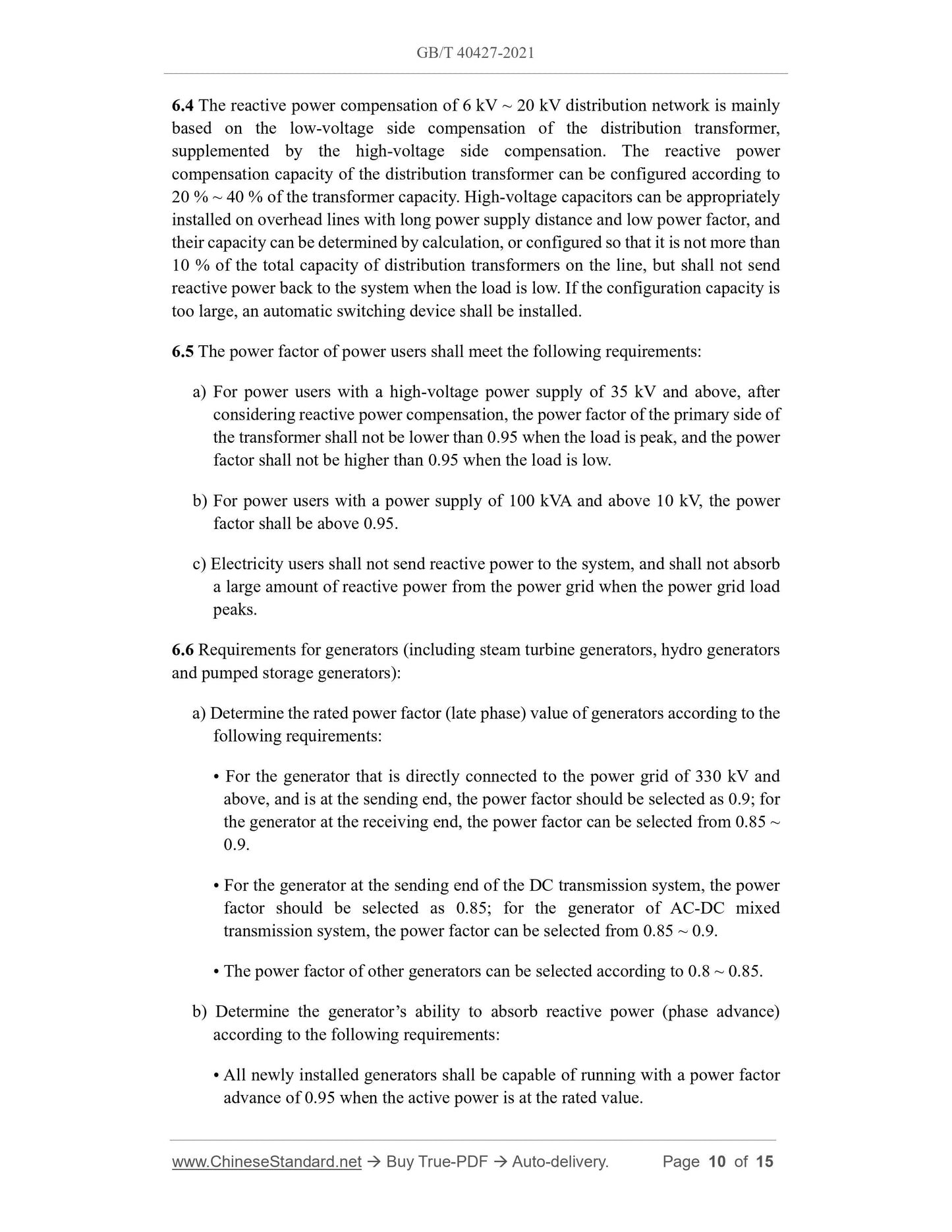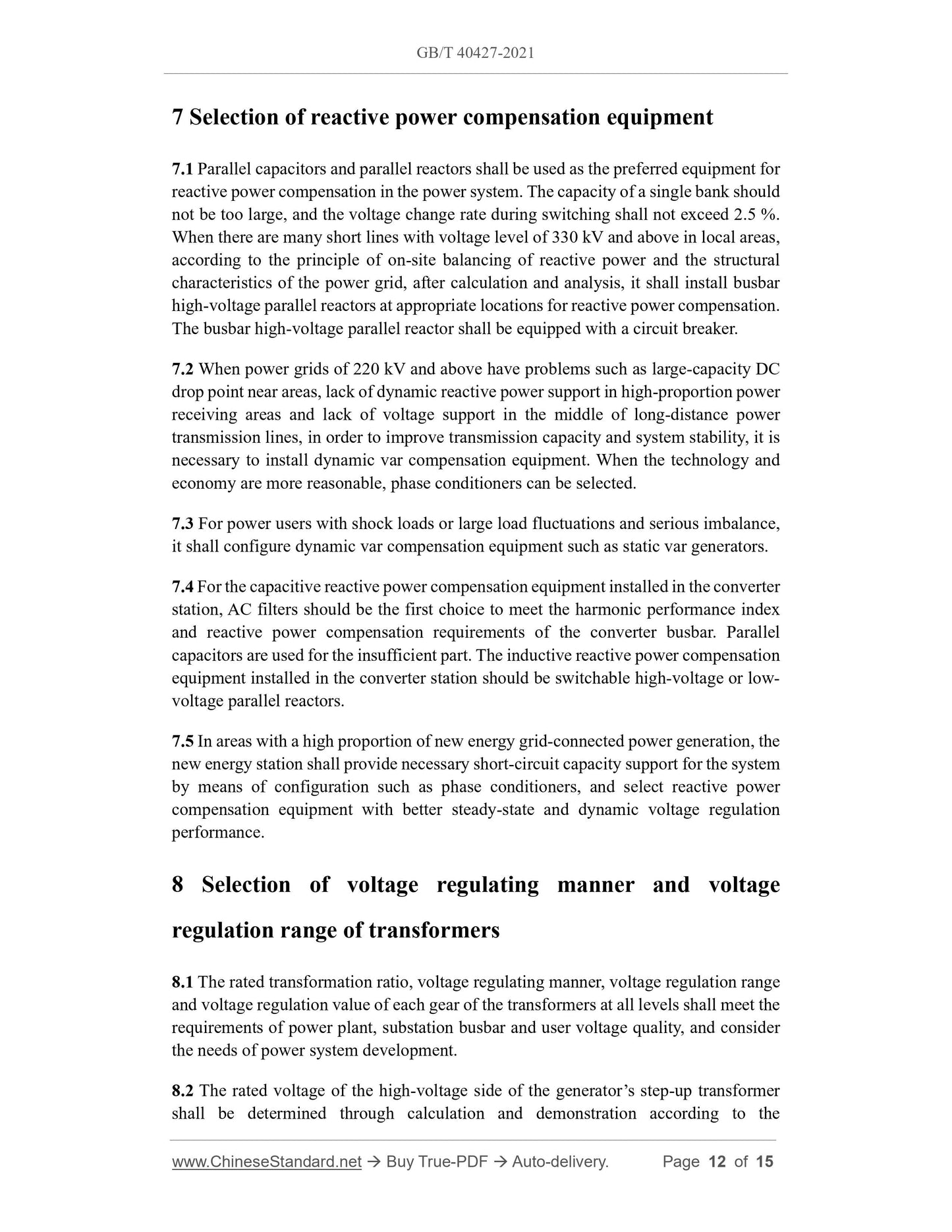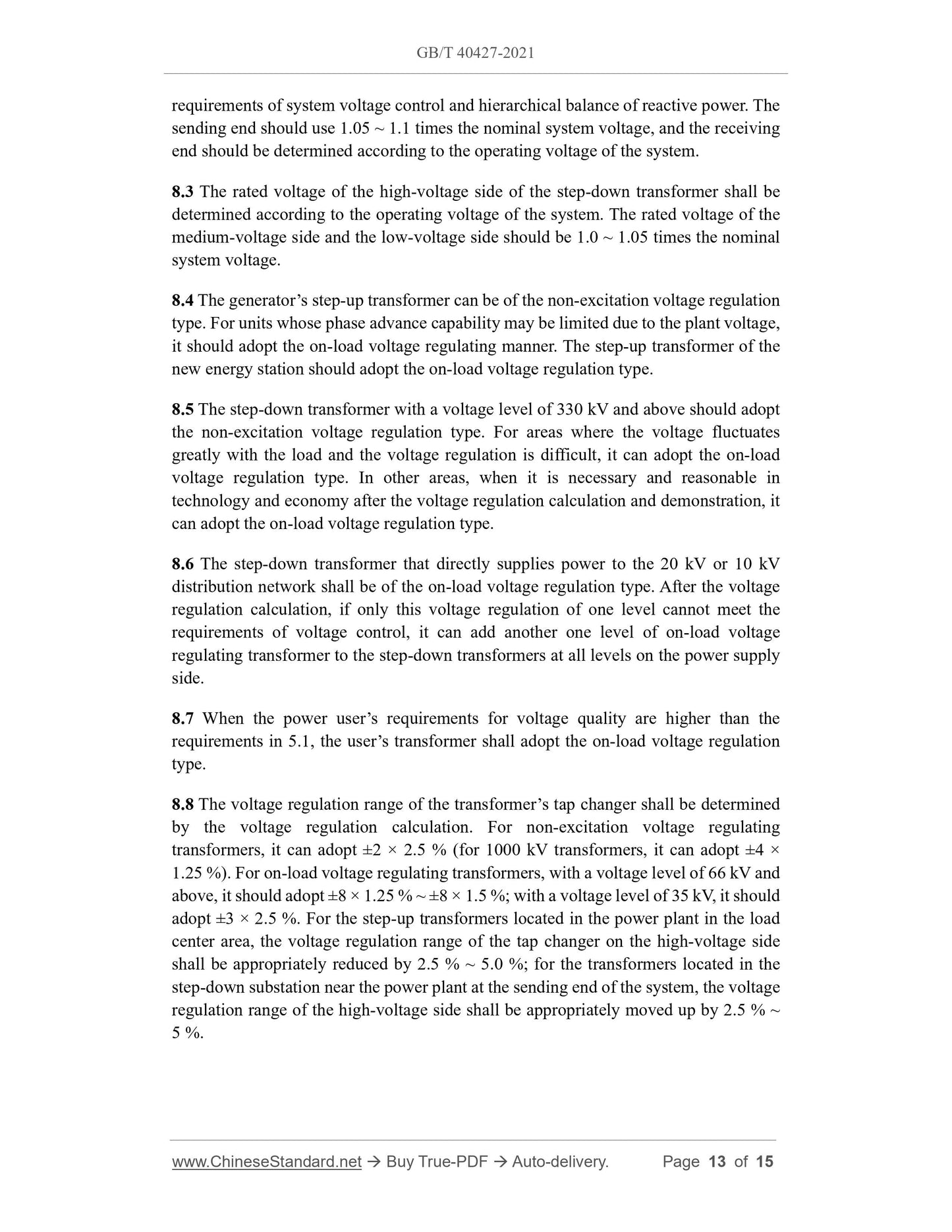1
/
of
9
PayPal, credit cards. Download editable-PDF and invoice in 1 second!
GB/T 40427-2021 English PDF (GBT40427-2021)
GB/T 40427-2021 English PDF (GBT40427-2021)
Regular price
$170.00 USD
Regular price
Sale price
$170.00 USD
Unit price
/
per
Shipping calculated at checkout.
Couldn't load pickup availability
Delivery: 3 seconds. Download true-PDF + Invoice.
Get QUOTATION in 1-minute: Click GB/T 40427-2021
Historical versions: GB/T 40427-2021
Preview True-PDF (Reload/Scroll if blank)
GB/T 40427-2021: Technical guidelines for power system voltage and reactive power
GB/T 40427-2021
GB
NATIONAL STANDARD OF THE
PEOPLE’S REPUBLIC OF CHINA
ICS 29.020
CCS F 21
Technical guidelines for power system voltage and reactive
power
ISSUED ON: OCTOBER 11, 2021
IMPLEMENTED ON: MAY 01, 2022
Issued by: State Administration for Market Regulation;
Standardization Administration of the People’s Republic of China.
Table of Contents
Foreword ... 3
1 Scope ... 4
2 Normative references ... 4
3 Terms and definitions ... 4
4 General requirements ... 6
5 Allowable voltage deviation ... 7
6 Reactive power balance and compensation ... 9
7 Selection of reactive power compensation equipment ... 12
8 Selection of voltage regulating manner and voltage regulation range of transformers
... 12
9 Reactive voltage control of power system ... 14
Bibliography ... 15
Technical guidelines for power system voltage and reactive
power
1 Scope
This document specifies the basic technical requirements for the voltage and reactive
power of various voltage levels of the power system, the allowable voltage deviation,
the reactive power balance and compensation, the selection of reactive power
compensation equipment, the selection of transformer voltage regulating manner and
voltage regulation range, and the reactive voltage control of the power system.
This document is applicable to the voltage control and reactive power configuration of
the power system of various voltage levels for power generation, transmission,
distribution and utilization.
2 Normative references
The following referenced documents are indispensable for the application of this
document. For dated references, only the edition cited applies. For undated references,
the latest edition of the referenced document (including any amendments) applies.
GB/T 19963 Technical specification for connecting wind farm to power system
GB/T 19964 Technical requirements for connecting photovoltaic power station to
power system
GB/T 31460 Technical guide for reactive power compensation and allocation of
HVDC converter stations
GB 38755 Code on security and stability for power system
GB/T 38969 Guide on technology for power system
NB/T 32015 Technical rule for distributed resources connected to distribution
network
3 Terms and definitions
For the purpose of this document, the following terms and definitions apply.
3.1
reverse voltage regulating manner
The voltage regulating manner in which the voltage of the central point is reversely
regulated with the increase or decrease of the load, that is, the voltage of the central
point is increased when the load is large, and the voltage of the central point is decreased
when the load is small.
3.8
balance of reactive
Under a certain system voltage level, the state in which the reactive output is balanced
with the reactive load of the reactive power source in the power system.
3.9
automatic voltage control; AVC
Using computer system, communication network and controllable equipment, calculate
the control strategy online according to the real-time operating conditions of the power
grid, and automatically closed-loop control the reactive power and voltage regulation
equipment, to achieve a reasonable reactive voltage distribution.
4 General requirements
4.1 The voltage of each voltage level node in the power system shall meet the
requirements of allowable voltage deviation.
4.2 The reactive power compensation of the power grid shall meet the principle of
hierarchical and on-site balancing under the highest and lowest load levels, shall be
adjusted with the load (or voltage) changes, and shall avoid the transmission of reactive
power through long-distance lines or multi-level transformers.
4.3 In the planning and design of the power system, it shall carry out the planning of
reactive power compensation equipment/reactive power source, and reserve an
appropriate margin.
a) In the planning and design of power generation, transmission, distribution and
utilization projects, it shall carry out special research on reactive voltage; if
necessary, it shall carry out calculation and analysis of overvoltage, including
power frequency overvoltage, operating overvoltage, resonance overvoltage,
submerged supply current and recovery voltage, etc.
b) In the planning and design of the receiving end system, it shall strengthen the
network connection of the highest-level voltage; it shall be connected to a power
source with sufficient capacity and support and adjustment capabilities to ensure
the flexibility of the voltage support and operation of the receiving end system; it
shall configure sufficient reactive power compensation capacity.
c) For DC drop points, load concentration areas and channels such as new energy
centralized transmission, it shall reasonably configure dynamic var compensation
equipment.
d) For the configuration of reactive power compensation equipment and the selection
of equipment type, it shall be compared technically and economically. For power
grids of 220 kV and above, it should consider the need to improve the stability of
the power system.
4.4 There shall be sufficient reactive power reserve for the operation of the power
system to ensure the normal operation of the power system and the voltage stability
after accident.
4.5 The synchronous generator or synchronous phase conditioner shall operate with
automatic regulation excitation (including forced excitation), with sufficient phase
advance and retardation capability, and maintain the stability of its operation.
4.6 The new energy station shall have reactive power regulation capability and
automatic voltage control function, and maintain the stability of its operation. In
principle, the reactive power regulation capability of the new energy station shall be
consistent with that of the synchronous generator set.
4.7 The distribution network below 110 kV shall adopt a reasonable power supply
radius.
4.8 According to the structure of the power grid and the nature of the load, it shall
reasonably select the voltage regulation range and voltage regulating manner of the tap
changer of the step-up and step-down transformer in the voltage network of all levels.
5 Allowable voltage deviation
5.1 Allowable voltage deviation at user’s receiving end
5.1.1 The sum of the absolute value of the positive and negative deviations of the user
power supply voltage of 35 kV and above shall not exceed 10 % of the nominal voltage.
5.1.2 The allowable deviation of the three-phase power supply voltage of 20 kV and
below shall be ±7 % of the nominal voltage.
5.1.3 The allowable deviation of 220 V single-phase power supply voltage shall be -
10 % ~ +7 % of the nominal voltage.
5.1.4 The allowable voltage deviation of special users shall be determined according to
the value agreed upon in the electricity supply contract.
5.2.7 A 10 kV (or 20 kV or 6 kV) busbar shall make the voltage of all the high-voltage
users of the line and the low-voltage users powered by the distribution transformer meet
the requirements of 5.1.
5.2.8 The allowable deviation of the voltage at the grid connection point of wind farms
and photovoltaic power stations: when the voltage of the public grid is within the
normal range, for the wind farm that is connected to the public grid with a voltage level
of 220 kV (or 330 kV) and below, the wind farm shall be able to control the voltage at
the grid connection point within the range of -3 ...
Get QUOTATION in 1-minute: Click GB/T 40427-2021
Historical versions: GB/T 40427-2021
Preview True-PDF (Reload/Scroll if blank)
GB/T 40427-2021: Technical guidelines for power system voltage and reactive power
GB/T 40427-2021
GB
NATIONAL STANDARD OF THE
PEOPLE’S REPUBLIC OF CHINA
ICS 29.020
CCS F 21
Technical guidelines for power system voltage and reactive
power
ISSUED ON: OCTOBER 11, 2021
IMPLEMENTED ON: MAY 01, 2022
Issued by: State Administration for Market Regulation;
Standardization Administration of the People’s Republic of China.
Table of Contents
Foreword ... 3
1 Scope ... 4
2 Normative references ... 4
3 Terms and definitions ... 4
4 General requirements ... 6
5 Allowable voltage deviation ... 7
6 Reactive power balance and compensation ... 9
7 Selection of reactive power compensation equipment ... 12
8 Selection of voltage regulating manner and voltage regulation range of transformers
... 12
9 Reactive voltage control of power system ... 14
Bibliography ... 15
Technical guidelines for power system voltage and reactive
power
1 Scope
This document specifies the basic technical requirements for the voltage and reactive
power of various voltage levels of the power system, the allowable voltage deviation,
the reactive power balance and compensation, the selection of reactive power
compensation equipment, the selection of transformer voltage regulating manner and
voltage regulation range, and the reactive voltage control of the power system.
This document is applicable to the voltage control and reactive power configuration of
the power system of various voltage levels for power generation, transmission,
distribution and utilization.
2 Normative references
The following referenced documents are indispensable for the application of this
document. For dated references, only the edition cited applies. For undated references,
the latest edition of the referenced document (including any amendments) applies.
GB/T 19963 Technical specification for connecting wind farm to power system
GB/T 19964 Technical requirements for connecting photovoltaic power station to
power system
GB/T 31460 Technical guide for reactive power compensation and allocation of
HVDC converter stations
GB 38755 Code on security and stability for power system
GB/T 38969 Guide on technology for power system
NB/T 32015 Technical rule for distributed resources connected to distribution
network
3 Terms and definitions
For the purpose of this document, the following terms and definitions apply.
3.1
reverse voltage regulating manner
The voltage regulating manner in which the voltage of the central point is reversely
regulated with the increase or decrease of the load, that is, the voltage of the central
point is increased when the load is large, and the voltage of the central point is decreased
when the load is small.
3.8
balance of reactive
Under a certain system voltage level, the state in which the reactive output is balanced
with the reactive load of the reactive power source in the power system.
3.9
automatic voltage control; AVC
Using computer system, communication network and controllable equipment, calculate
the control strategy online according to the real-time operating conditions of the power
grid, and automatically closed-loop control the reactive power and voltage regulation
equipment, to achieve a reasonable reactive voltage distribution.
4 General requirements
4.1 The voltage of each voltage level node in the power system shall meet the
requirements of allowable voltage deviation.
4.2 The reactive power compensation of the power grid shall meet the principle of
hierarchical and on-site balancing under the highest and lowest load levels, shall be
adjusted with the load (or voltage) changes, and shall avoid the transmission of reactive
power through long-distance lines or multi-level transformers.
4.3 In the planning and design of the power system, it shall carry out the planning of
reactive power compensation equipment/reactive power source, and reserve an
appropriate margin.
a) In the planning and design of power generation, transmission, distribution and
utilization projects, it shall carry out special research on reactive voltage; if
necessary, it shall carry out calculation and analysis of overvoltage, including
power frequency overvoltage, operating overvoltage, resonance overvoltage,
submerged supply current and recovery voltage, etc.
b) In the planning and design of the receiving end system, it shall strengthen the
network connection of the highest-level voltage; it shall be connected to a power
source with sufficient capacity and support and adjustment capabilities to ensure
the flexibility of the voltage support and operation of the receiving end system; it
shall configure sufficient reactive power compensation capacity.
c) For DC drop points, load concentration areas and channels such as new energy
centralized transmission, it shall reasonably configure dynamic var compensation
equipment.
d) For the configuration of reactive power compensation equipment and the selection
of equipment type, it shall be compared technically and economically. For power
grids of 220 kV and above, it should consider the need to improve the stability of
the power system.
4.4 There shall be sufficient reactive power reserve for the operation of the power
system to ensure the normal operation of the power system and the voltage stability
after accident.
4.5 The synchronous generator or synchronous phase conditioner shall operate with
automatic regulation excitation (including forced excitation), with sufficient phase
advance and retardation capability, and maintain the stability of its operation.
4.6 The new energy station shall have reactive power regulation capability and
automatic voltage control function, and maintain the stability of its operation. In
principle, the reactive power regulation capability of the new energy station shall be
consistent with that of the synchronous generator set.
4.7 The distribution network below 110 kV shall adopt a reasonable power supply
radius.
4.8 According to the structure of the power grid and the nature of the load, it shall
reasonably select the voltage regulation range and voltage regulating manner of the tap
changer of the step-up and step-down transformer in the voltage network of all levels.
5 Allowable voltage deviation
5.1 Allowable voltage deviation at user’s receiving end
5.1.1 The sum of the absolute value of the positive and negative deviations of the user
power supply voltage of 35 kV and above shall not exceed 10 % of the nominal voltage.
5.1.2 The allowable deviation of the three-phase power supply voltage of 20 kV and
below shall be ±7 % of the nominal voltage.
5.1.3 The allowable deviation of 220 V single-phase power supply voltage shall be -
10 % ~ +7 % of the nominal voltage.
5.1.4 The allowable voltage deviation of special users shall be determined according to
the value agreed upon in the electricity supply contract.
5.2.7 A 10 kV (or 20 kV or 6 kV) busbar shall make the voltage of all the high-voltage
users of the line and the low-voltage users powered by the distribution transformer meet
the requirements of 5.1.
5.2.8 The allowable deviation of the voltage at the grid connection point of wind farms
and photovoltaic power stations: when the voltage of the public grid is within the
normal range, for the wind farm that is connected to the public grid with a voltage level
of 220 kV (or 330 kV) and below, the wind farm shall be able to control the voltage at
the grid connection point within the range of -3 ...
Share
